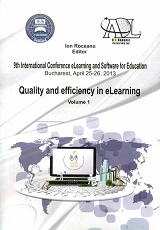USE OF ADAPTED SOFTWARE IN THE THERAPY OF LANGUAGE DISTURBANCES IN THE CASE OF THE INTELLECT DEFICIENT PEOPLE
USE OF ADAPTED SOFTWARE IN THE THERAPY OF LANGUAGE DISTURBANCES IN THE CASE OF THE INTELLECT DEFICIENT PEOPLE
Author(s): Florin Emil Verza, Marilena Bratu, Marinela VasileSubject(s): Education
Published by: Carol I National Defence University Publishing House
Keywords: educational software; language disturbances; therapies; mental deficiency
Summary/Abstract: The research hereby aims to reveal the specific features of logopedic intervention in terms of using some adapted software applications as well as to highlight a sheer reality of our century: a meaningful combination of the traditional therapeutic methods with hi-tech informatic equipment during the logopedic therapy can remarkably stimulate children into performing a stable activity, which consequently would lead to rewarding therapeutic progress. It is presumed that, in terms of using some software applications adapted to dyslexia and dysgraphia therapy for students with mental disabilities, some notable improvements would be registered in their evolution. It is also presumable that, by using an application with a symbols processor within the dyslexia and dysgraphia therapy for students with mental disabilities, some notable improvements would be registered in their aware reading of the texts. The present research has been made by a sample lot of 46 subjects (11 girls and 35 boys) with mental disabilities diagnosis and chronological age ranging from 10 to 12 years. Methods of data collection: Raven's Standard Progressive Matrices Test; proof set for assessing the language psychological age (Alice Descoudress); proof set for assessing the dyslexic and dysgraphic impairments. Subsequently to dyslexic and dysgraphic impairments noted to the students with mental disabilities within the lot, we advanced on the application-oriented part of the research. All students were involved in the ongoing activity pertaining to dyslexia and dysgraphia therapy, in compliance with their medical diagnosis and and their intellectual development level. The therapeutic activity designed for the experimental lot was also undergoing by implementing the same methodology as in the case of the control lot, while for accomplishing the set objectives, SymWriter educational software was extensively used, in order to prompt its efficiency during the targeted activity. The period of time when Widgit applications were used along the activities related to dyslexia and dysgraphia therapy was set for three months. At the end of the established period, the whole lot was again assessed by proof set means, thus to be enabled to mark the evolution of the students with mental disabilities. On examining the results of both the initial and final assessments for the control lot as well as for the experimental lot, we were finally led to the conclusion that, if using some software applications adapted to dyslexia and dysgraphia therapy, together with proceeding to some application assissted by a symbols processor, the progress in correcting the dyslexic-dysgraphic impairments were strikingly remarkable and meanwhile, notable progress was recorded in terms of aware reading of the texts.
Journal: Conference proceedings of »eLearning and Software for Education« (eLSE)
- Issue Year: 9/2013
- Issue No: 01
- Page Range: 274-279
- Page Count: 6
- Language: English

